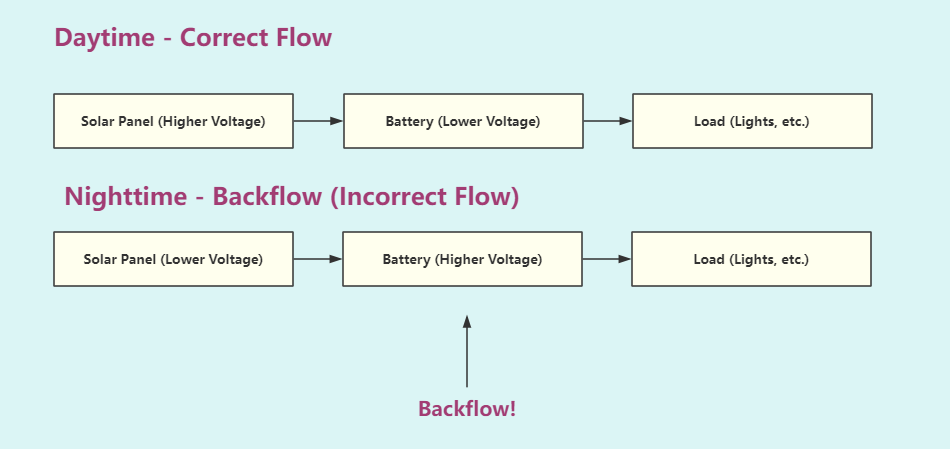Can Battery Voltage Flow Backwards and Damage a Solar Cell? Understanding Backflow
As a battery expert with years of experience in power systems, I often get questions about the interaction between solar panels and batteries. One crucial concern is backflow, also known as reverse current. This article will explain what backflow is, why it's a problem, and how to prevent it, ensuring the longevity and safety of your solar energy system.
Definition: Backflow is like electricity going the wrong way. It's also called reverse current, and it is not wanted. In a solar panel setup, it means power flows from the battery to the panel. That's the opposite of how it should work.
How it Happens: Voltage Difference: Power goes from places with more voltage to places with less. Your solar panels have a higher voltage than your battery during the day. Because of this, electricity flows into the battery, and it gets charged. The solar panel's voltage can drop at night, or it can fall on really cloudy days. When that happens, the voltage is lower than the battery. Current Direction: - This voltage difference can make the battery's power go back into the solar panel if nothing prevents it. There has to be a preventative measure. Think of it like water moving down a hill. Because electricity goes from high voltage to low voltage, the power "flows" just like that water.

Backflow isn't just a theoretical problem; it can cause real damage.
Damage to Batteries:
Battery Type Susceptibility to Backflow Damage Explanation Lead-Acid Moderate Can tolerate some backflow, but prolonged exposure leads to sulfation and damage. Lithium-ion High More sensitive to reverse current; can lead to internal damage and safety issues. Other (e.g., NiMH) Varies Check manfacturer's documentation Overheating: The reverse current can cause the battery to overheat, especially if the backflow is significant. Reduced Performance: Over time, backflow can degrade the battery's ability to hold a charge. Shortened Lifespan: Consistent backflow significantly reduces the battery's overall lifespan. Damage to Solar Panels: Reduced Efficiency: Backflow can make the solar panel less efficient at converting sunlight into electricity. Hot Spots: The reverse current can create "hot spots" on the panel, areas of concentrated heat that damage the solar cells. Permanent Damage: In severe cases, backflow can cause permanent damage to the solar panel, requiring replacement.
Safety Hazards: Overheated Wires: If the backflow current is high enough, it can overheat the wires in your system. Fire Risk: In extreme cases, overheated wires can pose a fire hazard. Energy Loss: Lower System Efficiency: Any energy flowing back into the solar panel is wasted energy, reducing the overall efficiency of your system. You're essentially using your battery to power your solar panel, which is the opposite of what you want!
Part 3: Preventing Backflow
Method 1: Schottky Diode Voltage Rating: Choose a diode with a voltage rating higher than the maximum voltage of your solar panel. Current Rating: Choose a diode with a current rating higher than the maximum current your solar panel can produce. Forward Voltage Drop: Schottky diodes have a small voltage drop (usually 0.2-0.5V). This means a tiny amount of energy is lost as heat in the diode, but it's much better than the energy lost to backflow. Principle: A Schottky diode acts like a one-way valve for electricity. It allows current to flow easily in one direction (from the solar panel to the battery) but blocks it in the opposite direction (backflow). It is chosen over a standard diode for its lower voltage drop. Selection Guide: Installation:

Pros & Cons: Pros: Inexpensive, simple to install. Cons: Small voltage drop (minor energy loss).
Method 2: Solar Charge Controller Voltage: Match the controller's voltage to your battery and solar panel voltage. Current: Choose a controller that can handle the maximum current from your solar panel. Features: Consider features like battery temperature monitoring, load control (for powering devices directly), and data logging. Principle: A solar charge controller is a more sophisticated device that sits between the solar panel and the battery. It automatically manages the charging process, preventing overcharging, undercharging, and backflow. Types of Charge Controllers: Type Principle Efficiency Cost PWM (Pulse Width Modulation) Simpler, less efficient; good for smaller systems Lower Lower MPPT (Maximum Power Point Tracking) More complex, more efficient; best for larger systems Higher Higher
Pros & Cons: Pros: Prevents backflow, optimizes charging, protects the battery, often includes additional features. Cons: More expensive than a diode.

